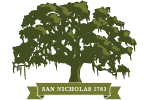The St. Nicholas neighborhood is one of the oldest in Florida, and has a rich and interesting history.
Fort San Nicolas was built by the Spanish in 1793 on the site of the present-day athletic fields of Bishop Kenny High School. The triangular battery was extended a few times and changed hands often between the Spanish and British during Florida’s colonial period. The fort was abandoned in 1818 and later razed. The surrounding land became a farm. Look for the historic marker about the fort in the Atlantic Boulevard median halfway between Kingman Avenue and Holmesdale Road.
The St. Nicholas neighborhood was initially defined as the area on the south bank of the St. Johns River generally bordered by the river and the area that is now Atlantic Boulevard, the Hart Bridge Expressway and Broadcast Place.
In 1820, citizens living in the area petitioned the Spanish governor to form a municipality call San Nicolas. The governor denied their request. If he hadn’t, Jacksonville may well have been called St. Nicholas! St. Nicholas was sparsely populated by recipients of two Spanish land grants, Francis Bagley and Reuben Hogans. After Bagley’s death, his grant, between Bishop Kenny High School and Miller’s Creek was divided up among his descendants. A small cemetery, now known as the Historic St. Nicholas Cemetery, was created at the corner of Olive and Linden Streets in the mid-1800’s for relatives, friends and neighbors.
After the Civil War in the late 1800’s, several homes, some of which still remain, were built in the St. Nicholas neighborhood for wealthy residents. The neighborhood slowly grew over the years to become a popular and pleasant residential neighborhood. The St. Nicholas neighborhood today remains a wonderful mix of new young families and long-time residents.
